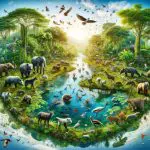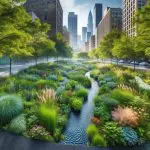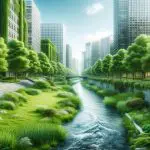
Explore the essentials of shaping sustainable futures – balancing today’s needs with tomorrow’s, using nature’s wisdom. Dive into a world where eco-friendly choices create a lasting impact!
Shaping Sustainable Futures Key Takeaways:
- Shaping sustainable futures involves balancing current environmental, social, and economic needs without compromising future generations’ ability. It’s about smartly using natural resources and embracing eco-friendly practices to ensure a healthy, thriving planet for years to come.
Welcome to our exploration of shaping sustainable futures!
Here, we embark on an exciting journey, unraveling how our choices today shape a greener, healthier tomorrow.
It’s about harnessing nature’s power and making smart, sustainable decisions.
Join us as we delve into the fascinating world of eco-friendly living and future-proofing our planet.
Shaping Sustainable Futures With Nature-Based Solutions
Imagine a world where our needs today don’t harm the future. That’s what sustainable futures are all about!
It’s like walking a tightrope, balancing today’s desires with tomorrow’s well-being.
In this section, we’ll explore this fascinating concept and discover how nature itself holds the key to this balance.
Definition of Sustainable Futures
What does Sustainable Futures really mean?
It’s a way of living and planning that ensures we don’t use up everything today, leaving nothing for future generations.
This idea, first shaped in the famous Brundtland Report, is like a promise to our children’s children, ensuring they have a healthy world to live in.
The Brundtland Report’s Vision:
This landmark report defined sustainable development as meeting our current needs without sacrificing the future.
It’s like having a cake and eating it too, but making sure there’s enough left for others.
Key Concepts:
-
-
- Essential Needs: It prioritizes the needs of the world’s poor, reminding us that sustainability isn’t just about the environment, but also about fairness and equality.
- Technological and Social Limits: The report emphasizes how our technology and society’s structures can limit or enhance our ability to be sustainable.
-
Importance of Nature-Based Solutions

Ever seen how plants and animals live in harmony with their environment?
That’s the magic of nature-based solutions! These are smart ways of solving our environmental problems by learning from nature.
In this part, we delve into how these solutions not only help our planet but also bring social and economic benefits.
Nature’s Role in Sustainability:
Nature-based solutions involve using natural processes to address environmental challenges.
Think of it like borrowing ideas from the way forests manage water or how wetlands filter pollutants.
-
- Benefits Beyond the Environment:
- Social Advantages: These solutions can create jobs, improve health, and build stronger communities. It’s like planting a tree that provides shade, fruits, and a place for people to gather.
- Economic Gains: Investing in nature can also be economically wise. For instance, restoring a wetland is often cheaper than building a water treatment plant and it brings more diverse benefits.
- Benefits Beyond the Environment:
Understanding Sustainable Futures
Sustainable Futures isn’t a new idea. It’s like an old tree with deep roots in history.
This section takes us on a journey back in time to see how the idea of living sustainably has grown and changed.
We’ll also look at the three big parts of sustainability and the challenges and opportunities it brings.
Historical Context
Our story of sustainability starts centuries ago. Think back to the 17th and 18th centuries when people first began managing forests thoughtfully.
This was the seed that grew into today’s idea of sustainable futures. Let’s travel through time and see how these early ideas have shaped our modern understanding.
Early Ideas of Sustainability:
-
- Sustainable Forest Management: Back in the day, people realized that if they cut down all the trees, there wouldn’t be any left for the future. This led to the idea of managing forests so they would last for years to come.
- Evolution Over Centuries: These early thoughts on using resources wisely have grown and spread into different areas like farming, fishing, and even city planning.
The Three Pillars of Sustainability
Sustainability stands on three strong pillars: environment, economy, and society.
It’s like a stool that needs all three legs to stand up. Each pillar plays a crucial role in keeping our world balanced and healthy.
Let’s dive into what each of these pillars means and why they’re so important.
- Environmental Sustainability:
- This is all about protecting our planet. It means looking after our water, air, plants, and animals. It’s like being a good guest in someone’s home, where we respect and take care of everything around us.
- Economic Sustainability:
- Here, we talk about money and jobs, but in a way that can last. It’s like running a business that doesn’t just think about today’s profits but also about being around for many years.
- Social Sustainability:
- This one’s about people and communities. It means making sure everyone has what they need, like education, healthcare, and a safe place to live. It’s about building a world where everyone can thrive and be happy.
Challenges and Opportunities
Reaching a sustainable future isn’t easy. It’s like solving a giant puzzle with many tricky pieces.
In this part, we’ll look at the challenges we face, like changing how we use energy or how we grow food.
But, it’s not all tough news. There are also exciting opportunities to make things better.
Challenges in Achieving Sustainability:
-
- Economic Challenges: It can be tough to change old ways of doing business to be more sustainable. It’s like asking someone to switch from an old, familiar path to a new, uncertain one.
- Social and Political Hurdles: Getting everyone to agree on sustainable practices can be hard. It’s like trying to get a big family to agree on what to have for dinner!
Opportunities for a Better Future:
-
- Innovation and Technology: New technologies, like solar power or electric cars, open doors to a cleaner, more sustainable future.
- Community and Global Cooperation: When communities and countries work together, big things can happen. It’s like a team working together to win a game.
Table 1: Pillars of Sustainability
| Pillar | Description | Impact |
|---|---|---|
| Environmental | Focus on protecting natural resources and biodiversity. | Ensures a healthy ecosystem for future generations. |
| Economic | Sustainable economic growth and responsible resource use. | Creates a stable and prosperous economy that meets today’s needs without harming future prospects. |
| Social | Emphasizing equality, health, education, and community well-being. | Builds resilient and inclusive communities, improving quality of life for all. |
In a Nutshell:
This section gives a clear, simple understanding of the history, pillars, challenges, and opportunities of sustainable futures, focusing on what readers are curious about.
Nature-Based Solutions Explained
Nature is not just about beautiful landscapes; it’s also a smart fixer-upper for our planet’s problems.
This section introduces ‘Nature-Based Solutions,’ a way to tackle environmental issues by using natural methods.
It’s like taking lessons from nature’s own playbook. We’ll define what these solutions are and explore how they work in real life with some cool examples.
Definition and Scope
Nature-based solutions (NBS) are like nature’s own toolkit for fixing environmental issues.
They use natural processes and systems to help solve challenges like climate change, water scarcity, and pollution.
In this part, we’ll break down what NBS are and how wide their impact can be.
Understanding Nature-Based Solutions:
-
- What Are They? Imagine using plants, trees, and wetlands to clean air and water, or restore habitats to protect biodiversity. That’s NBS in action.
- Wide-Ranging Impact: These solutions can do a lot! They help cool cities, reduce floods, and even support food and water security.
- Benefits Beyond the Environment: Besides helping nature, NBS also brings social and economic perks, like creating jobs and making communities healthier and happier.
Case Studies
Let’s look at real-world examples where Nature-Based Solutions have worked wonders.
From bringing forests back to life to planting trees in cities, these stories show how going natural can make a big difference.
They’re like success stories that prove nature’s power in action.
Forest Reforestation:
-
- Example: Restoring Forests in Brazil: In places like Brazil, reforesting has helped bring back lost forests. This not only boosts biodiversity but also improves the local climate.
- Impact: These forests act as massive carbon sinks, soaking up CO2, and providing homes for wildlife, while also supporting local communities.
Urban Tree Planting Initiatives:
-
- Example: Greening Cities, like Louisville, Kentucky: Cities like Louisville have planted thousands of trees to improve air quality and bring nature back into urban spaces.
- Benefits: These urban trees lower temperatures, clean the air, and create peaceful green spaces for residents to enjoy.
Table 2: Nature-Based Solutions and Their Benefits
| Solution | Description | Benefits |
|---|---|---|
| Forest Reforestation | Planting trees and restoring forest areas. | Enhances biodiversity, captures carbon, and regulates climate. |
| Urban Green Spaces | Incorporating parks and greenery in urban planning. | Reduces urban heat, improves air quality, and enhances mental health. |
| Sustainable Agriculture | Eco-friendly farming practices. | Preserves soil health, conserves water, and reduces chemical use. |
In a Nutshell:
This section sheds light on how nature itself can be our ally in creating a sustainable future. By showcasing practical examples, we illustrate the effectiveness and scope of Nature-Based Solutions in addressing environmental and societal challenges.
Strategies for a Sustainable Future
Shifting to a sustainable future is like changing the course of a big ship. It takes smart strategies and careful planning.
In this section, we’ll discuss three major strategies: transforming how we use energy, planning our cities and land use, and improving agriculture and food systems.
These are key moves in our journey towards a greener, healthier world.
Energy Transition
Moving away from fossil fuels to renewable energy is a big step towards a cleaner future.
It’s like switching from old, polluting engines to sleek, clean machines.
Here, we’ll explore why this shift is crucial and how nature-based solutions can play a big role in this energy makeover.
The Shift to Renewable Energy:
-
- Why It’s Needed: Fossil fuels like coal and oil have powered our world for a long time, but they also cause pollution and climate change. We need to switch to cleaner sources like solar, wind, and hydropower.
- Nature’s Role: Nature-based solutions, like bioenergy from plants or using natural landscapes to support wind and solar farms, can help make this transition smoother and more sustainable.
- Challenges and Opportunities: This change isn’t just about new technology, but also about creating new jobs and industries. It’s a chance to build a greener economy.
Land Use and Urban Planning

How we build our cities and use land can either harm or help our planet.
It’s like choosing the right building blocks for a healthy environment. In this part, we’ll dive into how urban planning and land use can include nature to create sustainable living spaces.
Building Greener Cities:
-
- Incorporating Nature in Urban Design: Imagine cities with more parks, green roofs, and gardens. These green spaces can cool cities, reduce flooding, and improve air quality.
- Sustainable Land Use: This is about using land wisely. It means not taking up too much space for buildings and roads, and leaving room for nature to thrive.
- Benefits for People and Nature: When cities and lands are planned with nature in mind, it’s good for the environment and people’s health and happiness.
Agriculture and Food Systems
The way we grow food and manage our agriculture can have a big impact on the planet.
It’s like choosing ingredients for a healthy meal.
This section looks at how sustainable farming practices and food systems can help feed the world without hurting the environment.
Sustainable Agriculture Practices:
-
- Farming with Nature: This includes using fewer chemicals, rotating crops to keep the soil healthy, and using natural ways to control pests.
- Reducing Food Waste: A big part of sustainability is making sure we use food wisely and don’t waste it.
Impact on the Environment and Society:
- Less Pollution and More Biodiversity: Sustainable farming helps keep water clean and supports a variety of plants and animals.
- Healthier Food and Communities: When farms are sustainable, they can produce healthier food and support strong, vibrant rural communities.
Table 3: Strategies for a Sustainable Future
| Strategy | Description | Importance |
|---|---|---|
| Energy Transition | Switching from fossil fuels to renewable energy sources. | Reduces greenhouse gas emissions and combats climate change. |
| Urban Planning | Designing cities for sustainability. | Creates healthier living environments and reduces resource consumption. |
| Sustainable Food Systems | Improving food production and distribution methods. | Ensures food security and reduces environmental impact. |
In a Nutshell:
In this section, we have highlighted the essential strategies required for steering our world towards a sustainable future.
These strategies involve major changes in how we use energy, design our living spaces, and produce our food, all of which are critical steps towards a more sustainable and thriving planet.
Long-Term Thinking and Scenario Planning
Planning for a sustainable future is like playing a complex game of chess; it requires thinking several moves ahead.
In this section, we delve into futurology and scenario planning. These are tools that help us imagine and shape the future by considering different possibilities and preparing for them today.
The Role of Futurology
Futurology is the science of the future. It’s like having a crystal ball, but instead of magic, we use knowledge and trends to predict what might happen.
This part explains how futurology and scenario planning are crucial in guiding us toward sustainable futures, emphasizing the importance of long-term thinking.
Understanding Futurology:
-
- What is Futurology? It’s a way of studying the future to predict and shape it. Futurologists look at current trends, like climate change or technological advances, to guess what’s coming next.
- Scenario Planning: This is a key tool in futurology. It involves creating different what-if stories about the future. These scenarios help us prepare for various possibilities, from the best to the worst-case situations.
Benefits of Long-Term Thinking:
-
- Better Preparedness: By thinking ahead, we can plan for different futures, making us better equipped to handle challenges.
- Informed Decision Making: Long-term thinking helps policymakers and businesses make smarter choices today that will affect the future positively.
Building Sustainable Future Scenarios

Creating scenarios for a sustainable future is like drawing a map for a journey we’ve never taken before.
It’s about imagining different paths we could take and choosing the best one.
Here, we talk about how scenario planning and backcasting can help invent and reinvent our futures.
Crafting Future Scenarios:
-
- Inventing Futures: This involves thinking creatively about what the future could look like. It’s not just about predicting but also about dreaming up new ways of living sustainably.
- Using Backcasting: Backcasting starts with an ideal future scenario and then works backward to figure out how to get there. It’s like setting a goal and then planning the steps to achieve it.
Why It Matters:
-
- Creating a Vision: These scenarios give us a clear picture of what a sustainable future could look like.
- Guiding Policies and Actions: They help governments and organizations make plans that align with these visions, ensuring that our actions today lead us to a desirable future.
In a Nutshell:
In this section, we have explored how the concepts of futurology and scenario planning are essential in shaping a sustainable future.
By thinking long-term and using tools like backcasting, we can better prepare for what’s ahead and make decisions today that will lead to a healthier, more sustainable world tomorrow.
Shaping Sustainable Futures FAQs
Got questions about sustainable futures and nature-based solutions? You’re not alone!
In this FAQ section, we tackle some common queries. Think of it as your quick guide to understanding this important topic.
Let’s dive into these questions and answers to shed more light on how we can shape a better future together.
Q: What exactly is a sustainable future?
A: A sustainable future is one where we meet our current needs without compromising the ability of future generations to meet theirs.
It’s about finding a balance between using our resources wisely and protecting the environment, so the planet stays healthy and habitable for everyone, now and in the future.
Q: How do nature-based solutions help in achieving a sustainable future?
A: Nature-based solutions use natural processes to tackle environmental problems.
This can include planting trees to absorb carbon dioxide, restoring wetlands to purify water, or using green spaces in cities to reduce heat.
They’re effective because they work with nature, not against it, offering benefits for the environment, people, and the economy.
Q: Why is the transition to renewable energy important for sustainability?
A: Transitioning to renewable energy is crucial because it reduces our reliance on fossil fuels, which are major contributors to air pollution and climate change.
Renewable energy sources like solar and wind are cleaner, reducing greenhouse gas emissions and helping to protect the environment for future generations.
Q: Can sustainable agriculture really make a difference in our food systems?
A: Absolutely! Sustainable agriculture involves practices that maintain soil health, conserve water, and reduce the need for chemical pesticides and fertilizers.
This approach helps ensure that we can produce enough food for everyone without harming the environment. It’s about growing food in ways that are good for the earth and for us.
Q: What is the role of urban planning in creating sustainable futures?
A: Urban planning plays a big role in sustainability by designing cities that are environmentally friendly and livable.
This includes creating green spaces, using eco-friendly building materials, and designing cities so that people can walk or cycle instead of using cars.
Good urban planning can reduce pollution, save energy, and make cities more pleasant places to live.
Q: How can I, as an individual, contribute to a sustainable future?
A: Everyone can play a part! Simple actions like recycling, using less water, reducing energy consumption, and choosing sustainable products can make a big difference.
Also, supporting policies and initiatives that promote sustainability, and educating others about the importance of these issues, are great ways to contribute.
In a Nutshell:
These FAQs provide a snapshot of the key aspects of sustainable futures and nature-based solutions.
By understanding and addressing these questions, we can all contribute to making our world a healthier and more sustainable place.
Sustainable Futures with Nature-Based Solutions Conclusion
The Road Ahead: As we come to the end of our journey through Shaping Sustainable Futures With Nature-Based Solutions, let’s recap the key points.
• We’ve explored the concept of sustainable futures, which is all about balancing our current needs with those of future generations.
• We delved into nature-based solutions, showcasing how nature itself offers effective strategies to address environmental challenges.
• From the transition to renewable energy to sustainable agriculture and urban planning, we’ve seen how integrated, nature-friendly approaches can lead to a more sustainable world.
Remember, achieving a sustainable future is not just about big policies and technologies; it’s also about how we live and the choices we make every day.
Nature-based solutions are not just tools for policymakers and businesses; they are also actions that individuals and communities can adopt.
Read more: Nature-Based Solutions to Climate Change
Call to Action:
Now, it’s over to you! You have the power to make a difference. Start by incorporating sustainable practices into your daily life.
Whether it’s opting for public transportation, reducing waste, conserving water, or supporting local eco-friendly initiatives, every action counts. Encourage those around you to do the same.
And remember, supporting and advocating for nature-based solutions in your community is a powerful way to contribute to a more sustainable world.
Together, let’s embrace the challenge and opportunity of shaping a sustainable future, where nature and humanity thrive side by side.
Your actions, no matter how small, can pave the way for a greener, more sustainable tomorrow. Let’s make it happen!
References
For further reading and in-depth information, the following sources were referenced in creating this blog post:
- A Sustainable Future: Two Paths to 2050 by The Nature Conservancy. This source provided insights into the challenges and opportunities in achieving sustainable futures and the role of energy transition and nature-based solutions. Read more
- Sustainable Development – Wikipedia. This page offers a comprehensive overview of the concept of sustainable development, its historical context, and related concepts. Read more
- The Study of Sustainable Futures by Maria Alejandra Gonzalez-Perez, from Emerald Insight. This source discusses the importance of long-term thinking and scenario planning in sustainable futures. Read more
These sources provide a wealth of information for anyone interested in delving deeper into the topics of sustainable futures and nature-based solutions.







